Deezer Review
Deezer Review
Flexible music streaming without the wow factor
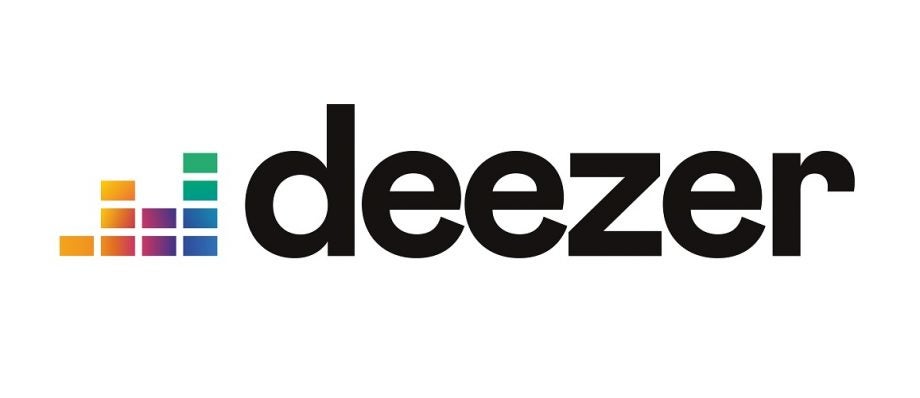
Verdict
Deezer has made some much-needed improvements in recent years that absolutely make it one to consider when thinking about subscribing to a streaming service.
Pros
- Affordable CD-quality streaming
- Huge catalogue of songs
- Sounds great
- Good device support
Cons
- Music discovery is done better elsewhere
- Algorithm can be hit and miss
Key Specifications
- Review Price: £14.99/month
- On-demand music streaming of over 56 million songs
- Apps for desktop, web and smartphone
- Three separate pricing tiers
- CD-quality audio available
- Support for Sony 360 Reality Audio
Deezer is an online music streaming service, and one of Spotify’s oldest rivals, founded just a year later than the Swedish powerhouse in 2007.
Despite this long-standing reputation, and an impressive catalogue of 56 million tracks, podcasts and radio stations, Deezer hasn’t managed to have the same impact as its rival, with just 16 million monthly active users compared to Spotify’s whopping 271 million.
But with interesting features and pricing tiers to suit every budget and preference, including a CD-quality “HiFi” tier yet to be offered by Spotify, should you be taking a closer look at Deezer when considering where to spend your streaming budget? Let’s take a closer look.
Deezer price and availability
Deezer is available in a number of price plans with individual, student and family options. There’s also limited ‘Free’ version that plays with ads.
The Premium tier unlocks all 73 million tracks on the service and ad-free listening. That’s priced at £9.99 / $9.99 / AUD$11.99 / €9.99 / CAD$9.99, and you get the first three months free.
Annual premium costs £89.91 / $99.90 / CAD$99.90 / AUD$119.90 / €99.90. If you choose to pay in one sum, you get 12 months for the price of 9.
The Student plan is £4.99 / $4.99 / CAD$4.99 / AUD$5.99 / €4.99. The first month is free with this option.
The Family plan offers up to six accounts and costs £14.99 / $14.99 / CAD$14.99 / AUD$17.99 / €14.99. The first month is free.
The Hi-Fi and Hi-Fi Family subscription plans offers music in lossless quality. The Hi-Fi plan costs £14.99 /$14.99 / CAD$14.99 / AUD$17.99 / €14.99 and the Hi-Fi Family version costs £19.99 / $19.99 / CAD$19.99 / €19.99. The Hi-Fi Family plan is not yet available in Australia.
Deezer interface — Clean, fuss-free and simple
- More consistent experience across devices/platforms
- Dark Mode/Light Mode
The Deezer layout across web, desktop and mobile is clean, fuss free and easy to use, and since we last reviewed it, has been simplified and standardised so jumping between the different apps feels much more cohesive.
The default “light mode” that’s pre-selected when you first log in is a little clinical looking though, with an abundance of white space that won’t be to everyone’s taste. We much preferred toggling to dark mode within the settings, to get a black background that’s much easier on the eye.
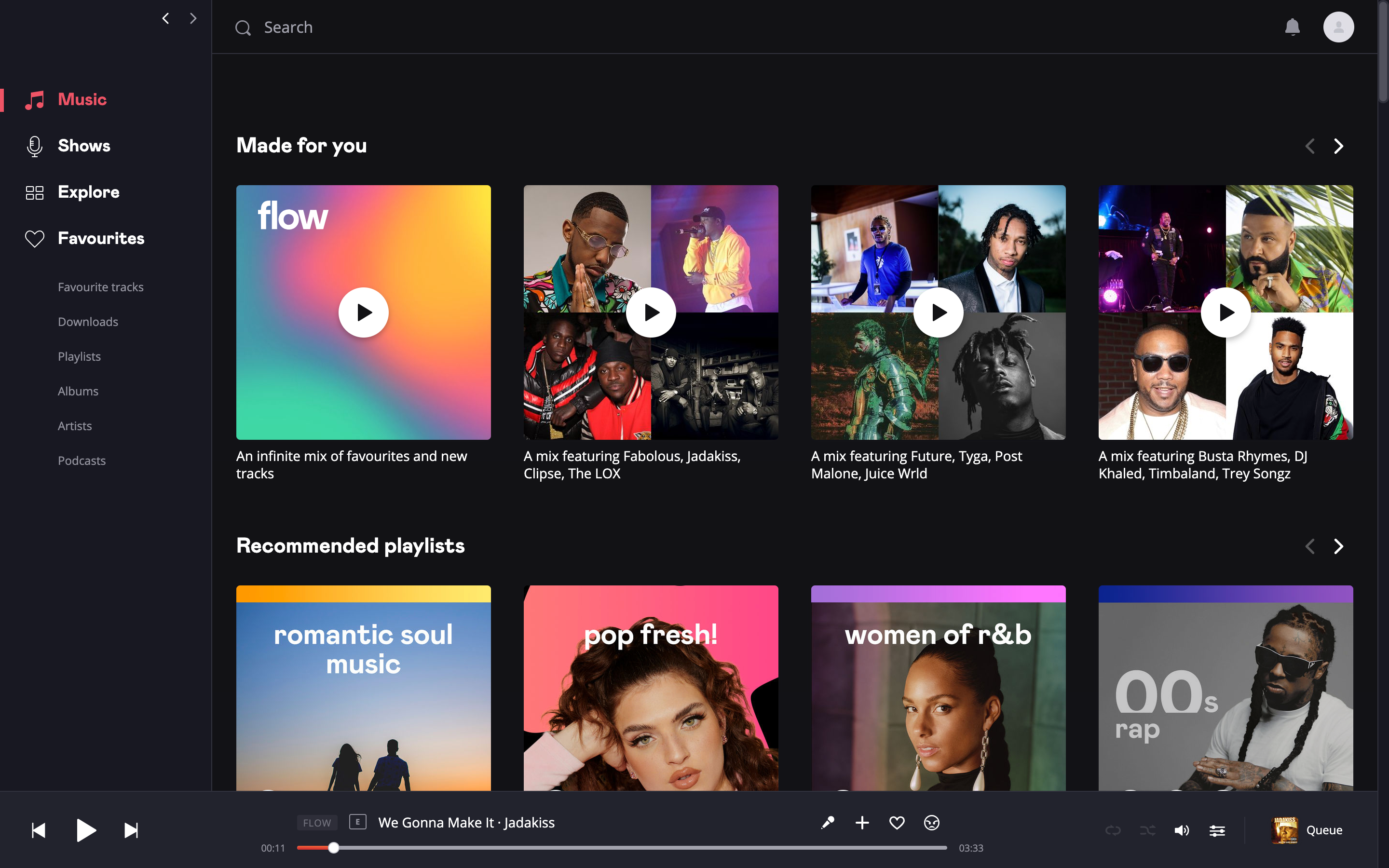
The browser and web versions are identical, with navigation links for Music, Shows, Explore and Favourites down the left-hand side, and a scrolling homepage for your chosen content in the middle.
The Music section generally contains suggested playlists and albums, with a selection of mixes and playlists made based on your listening habits at the top.
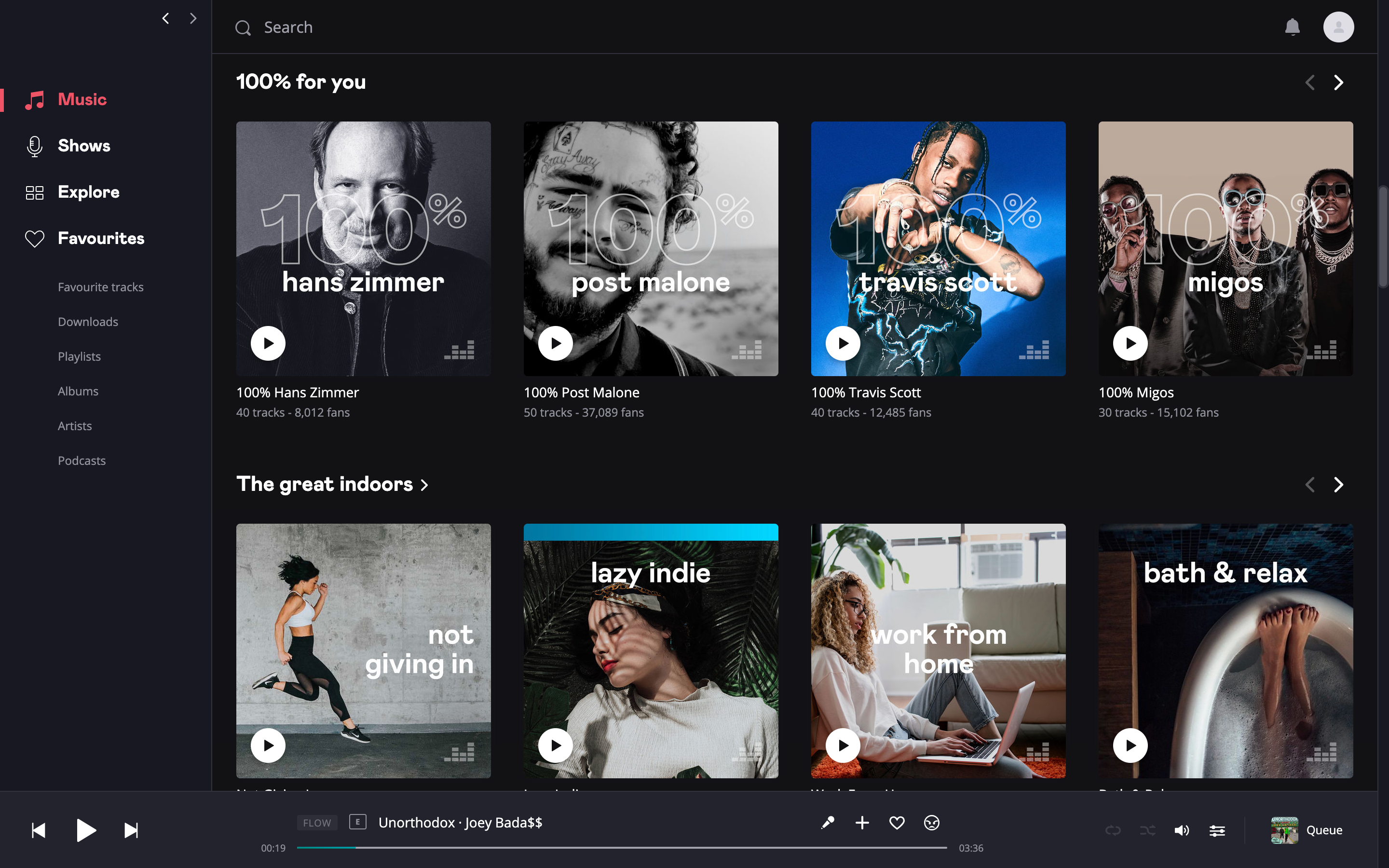
Shows is where you’ll find podcasts and radio stations, while Explore is basically a hub for different music genres and moods. You can click on any one of them on to be taken to a whole host of content that should scratch your musical itch, while Favourites is the place to go to find – well – any content you’ve favourited, surprisingly.
You can do that at any point by clicking the heart icon in the Now Playing bar, which runs along the bottom, while a search bar runs along the top.
A small thumbnail of artwork sits in the bottom right hand corner. Click this and the Now Playing bar becomes full screen, with larger artwork and details of what’s in the queue.
The smaller screen on mobile means there are a few differences. The dedicated Explore screen is ditched, and you’ll find genre and mood recommendations dotted throughout the Music and Search screens instead. It’s just as simple to navigate though, and serves up a near-identical array of content, just with a user interface that’s better optimised for mobile and touch navigation.
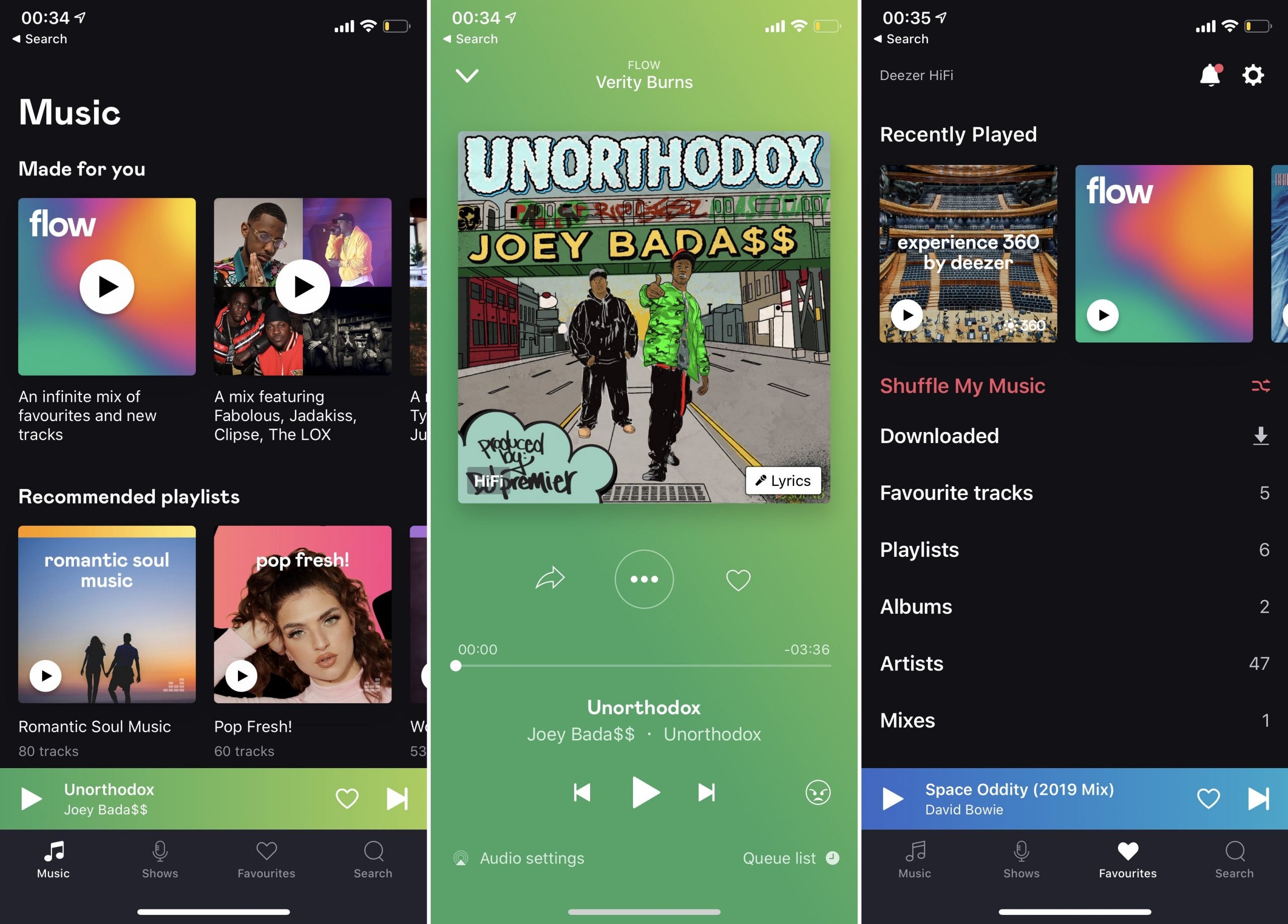
Deezer curation — Plenty of playlists to choose from
- Both human and automated curation
- Discovery could be better
You won’t find yourself wanting for playlists with Deezer – there are tonnes to choose from. This might be down to mood, artist, era or genre, plus Deezer has a few of its own series, such as the live Deezer Sessions and workout playlists curated and introduced by artists.
The more generic playlists have human curators behind them, and they’re good – though they rarely throw up many surprises. If you prefer your playlists to be full of songs you’re familiar with, then Deezer does a fantastic job of delivering the heavy hitters and chart toppers that you’d pick out for a party.
That continues in the personalised playlists, which are produced automatically based on your listening habits. My Flow is described as an infinite mix of favourites and new tracks, and did a great job of delivering song after song I didn’t want to skip, but very little by way of discovery.

This, unsurprisingly, is supposed to be handled by the Discovery playlist, updated weekly and described as offering “brand new tracks and music that’s just brand new to you”. But which hip hop and R’n’B fan hasn’t heard Pony by Ginuwine, Return of the Mack by Mark Morrison or Straight Outta Compton by N.W.A.?
There were around 15 out of the 40 songs that I hadn’t heard previously, but not all of those made sense to be included. Considering the listening profile that Deezer suggests to me elsewhere, the inclusion of blues rock guitarist Dan Auerbach and dance music producer Panteros666 seemed somewhat out of place, while 80s pop anthem Venus by Bananarama made no sense whatsoever.
Deezer catalogue — Huge number of recording artists
- Three subscription tiers/quality settings
- CD quality tracks
- Won’t have podcasts exclusive to Spotify
Deezer says it has over 56 million tracks, podcasts and radio stations in its catalogue, which puts it in the ballpark with the industry’s biggest players – Apple Music and Tidal boast 60 million and Spotify promises “over 50 million”.
Is the difference between them noticeable? Not from my experience. Everything song, album or artist I searched for on Deezer, I found – even lesser known regional artists didn’t fluster its search functionality.
The only thing worth considering is Spotify does have a huge catalogue of podcasts that are exclusive to its platform. If you’re considering switching services and that’s important to you, it’d be worth checking that your favourite is on Deezer before you do (though they’re all available for free on Spotify anyway).
Depending on which package you subscribe to, Deezer has up to three different quality settings. Deezer Free, the company’s ad-supported tier, is limited to 128kbps, Deezer Premium (£9.99/month) matches Spotify at 320kbps, while the HiFi tier that streams in CD quality (16-bit/44kHz) has recently been dropped to beat Tidal and match Amazon Music HD, at £14.99 per month.

It’s worth noting that Amazon Music HD goes all the way up to 24-bit high-resolution for the same price, plus Prime subscribers can get it even cheaper, for just £12.99 per month.
Almost the entire Deezer catalogue is available in CD quality, whether you’re using the desktop, web or and mobile app. That’s an improvement from the last time we reviewed the service, and makes the CD quality tier all the more tempting for those who value the improved sound quality.
It’s worth making sure that you’re streaming in the right quality though, as you can adjust it and the default isn’t always the best quality. On the desktop and web apps you’ll find the controls in the Now Playing bar, but you’ll have to dig a little deeper to get the very best quality on mobile. Be sure to set your controls to High Fidelity in the Custom menu to ensure you’re always hearing the very best.
Deezer sound quality — Great sound but you need to the kit to take advantage of it
- Excellent sound quality
- Supports 360 Reality Audio (in a different app)
- Will need good kit to get the best out of it
And how does it sound? Well it sounds great, but how much difference you’ll hear will depend on your kit. When listened to through a fairly common setup – be that smartphone and wireless headphones or a MacBook and wired headphones – the HiFi tier does sound better than the service’s lossy options, but it’s subtle.
Critical ears will notice the nuances in the dynamics, the improved space and a fuller body to the sound, but you’re really going to reap the benefits of the HiFi tier if you use a DAC, have top-quality headphones or if you’re streaming at home to hi-fi kit.
Tidal still pips Deezer for absolute sound quality too, by offering true hi-res streaming (typically 24-bit/94kHz) for an extra fiver a month (£19.99) on over a million of its tracks.
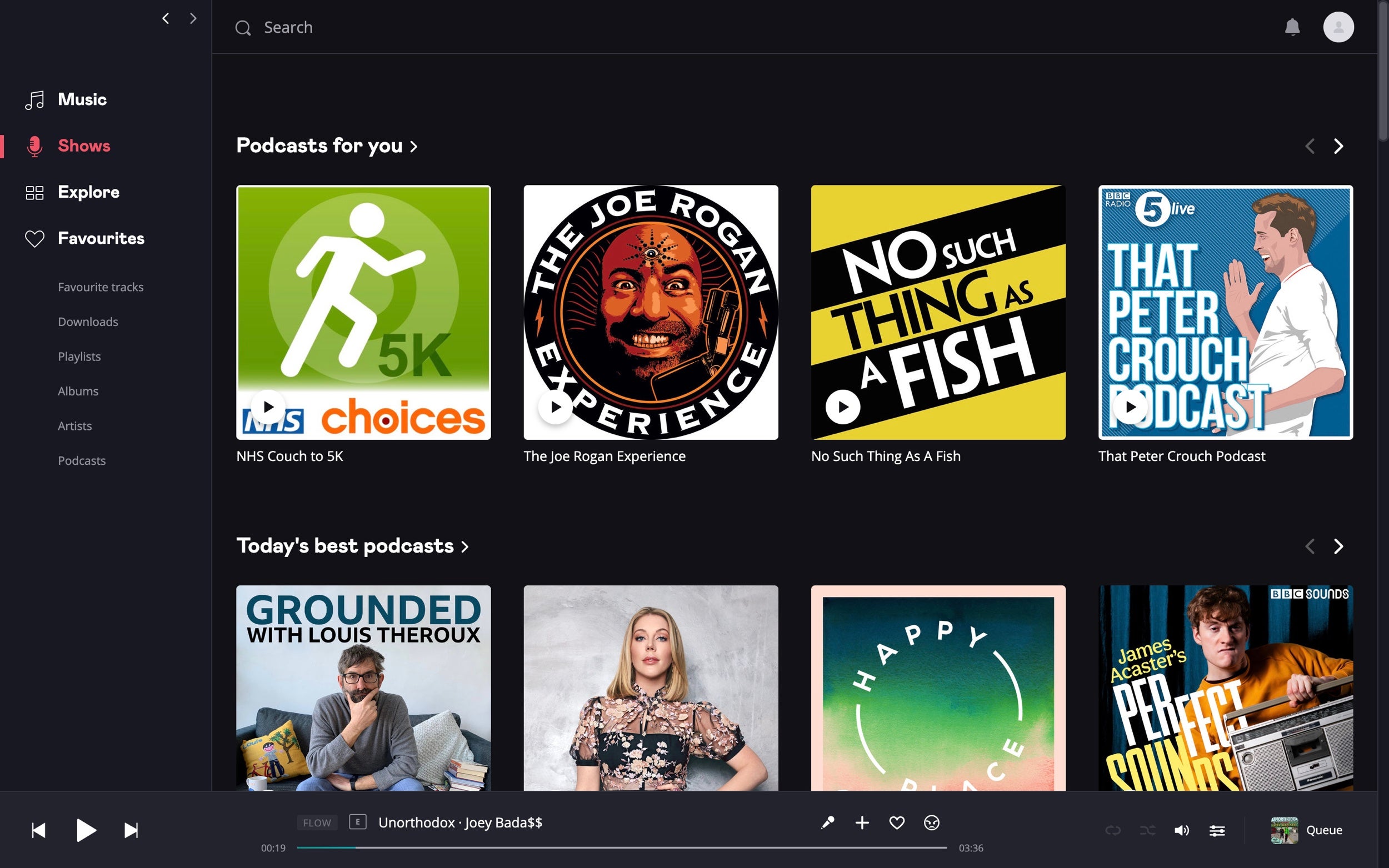
Still, Deezer’s HiFi tier comes with one extra trick up its sleeve, and that is Deezer 360. Currently a standalone app for mobile only, Deezer 360 is a place where you will find tracks mastered in 360 Reality Audio – a Sony format that aims to offer a more immersive experience in a 3D sound space.
You can listen using any pair of headphones but the experience has been optimised for six pairs of Sony cans – the WH-1000XM3, WF-1000XM3, WI-1000XM2, WH-XB900N, WH-XB700 and the WH-H910N. Unfortunately there’s no support for other 360 Reality Audio devices, like the Amazon Echo Studio just yet.
The selection is limited at the moment, though Deezer has said it will be adding more as they become available. In the meantime, the app merges 360 Reality Audio tracks and a number of regular stereo tracks to make it seem less bare, as well as your favourites from the standard Deezer app.
This only begs the question as to why the 360 RA tracks couldn’t just be included in the main Deezer app, as currently, the experience is pretty limited to open up a whole different app.
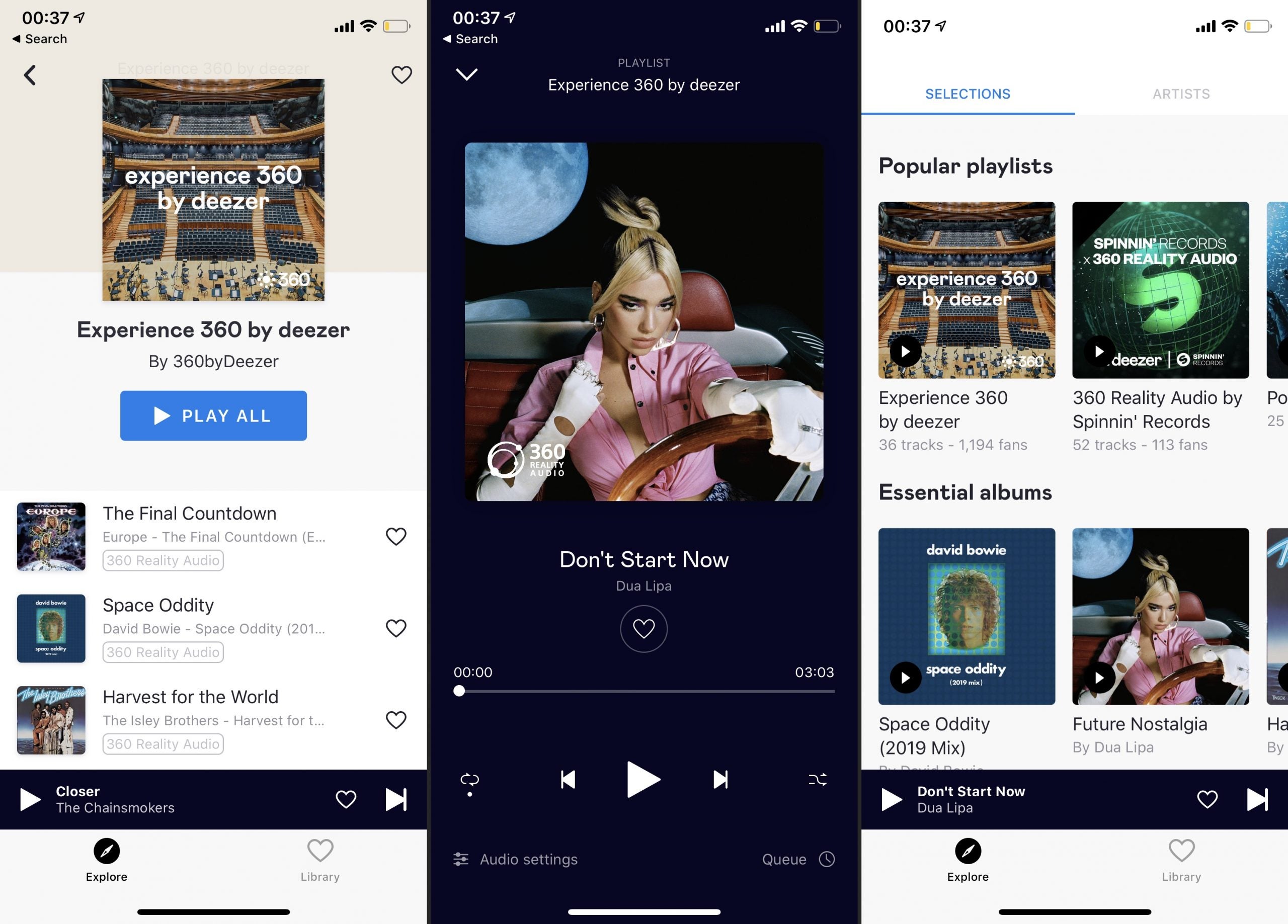
It’s also a bit of a mixed bag as to how good the available tracks sound in the format. At its best, there is undoubtedly more space between instruments and vocals, and the placement of instruments can be pinpointed with quite alarming accuracy. However, while it can absolutely put you at the centre of a song in a way that we haven’t experienced before, I’m still not sure I would currently pick a 360 RA song over a stereo one.
Overall they sound a little hollow and echoey, which leads to a lack of solidity and punch, almost like when a concert or theatre EQ is used.
I also noticed that some appear to be more effective in the format than others – I’m not sure I would’ve noticed the difference in Europe’s The Final Countdown, while Britney’s Me Against the Music sounds particularly unnatural. Dua Lipa’s Don’t Start Now, on the other hand, is a fantastic example of 360 RA’s potential.
Until the format is more effective across the board, and there are more tracks to experience it with, the addition is a nice-to-have, but is not currently a reason to opt for Deezer over another service.
Deezer connectivity — Comprehensive support
- Wide platform support
- Supported by Fitbit smartwatches
- Native support on Bluesound, Bose and Sonos kit
As one of the longer standing streaming services, you’d expect Deezer to be well equipped in the connectivity department, and you’d be right. The mobile app supports both Apple AirPlay and Google Chromecast playback, and you can also use your account on your voice-controlled speaker of choice – it’ll work with Google Home and there’s an Alexa skill for Amazon Echo.
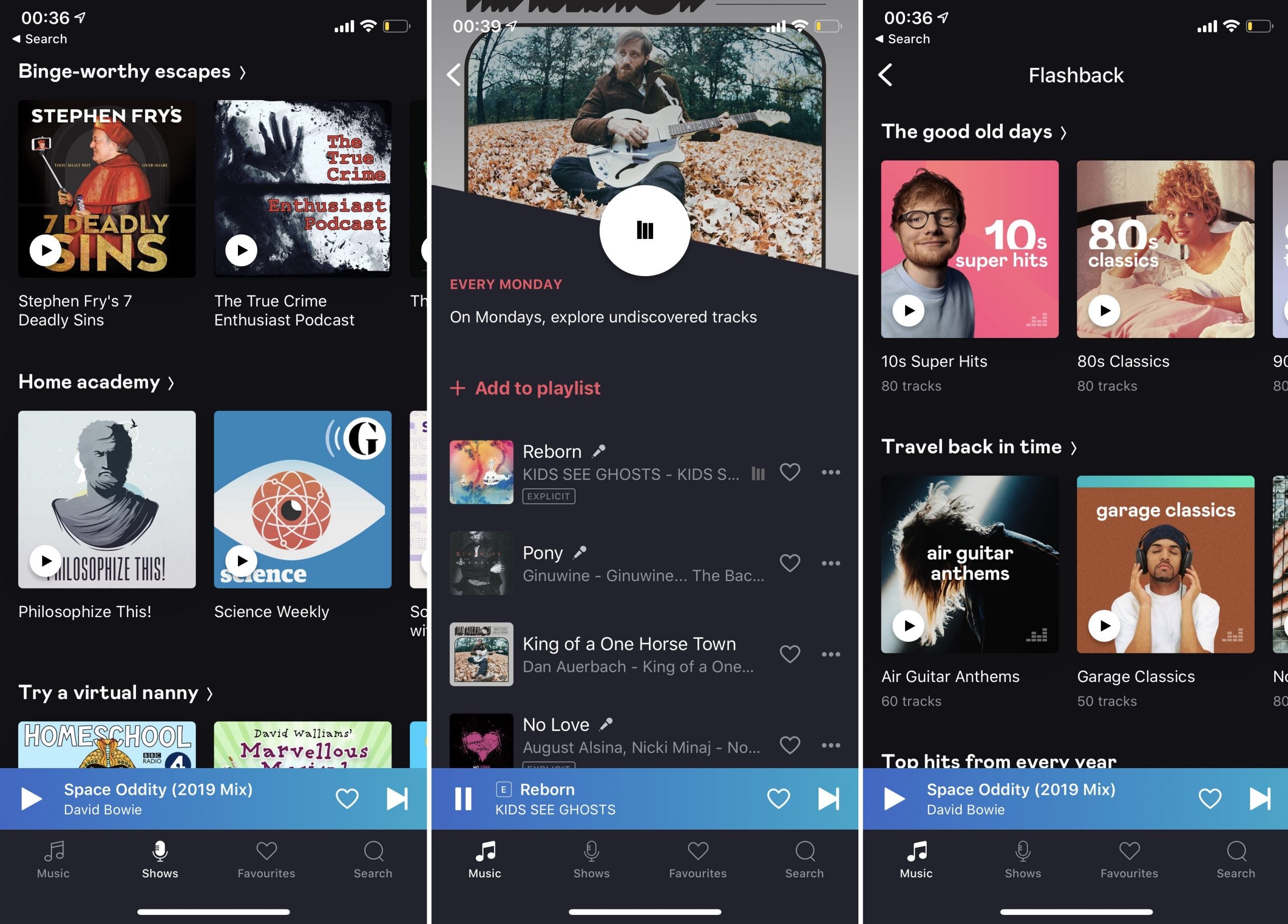
Deezer also works with a load of hi-fi and home entertainment kit, including Sonos, Bose, and Bluesound, plus wearables like the Apple Watch, Garmin smartwatches and the Fitbit Versa/Versa 2 and the Ionic.
There are also Deezer apps available for most major TV brands, the Xbox One and various set-top boxes. You can even find it on in-car systems, including Android Auto, Apple CarPlay and those that come pre-installed from a number of manufacturers, such as BMW and Mini.
Phew.
You should subscribe to Deezer if…
- You want affordable, CD quality music to listen to
The user experience is better across platforms, the HiFi tier can now be accessed no matter how you’re listening to it and it’s available just about everywhere you could want it to be. Not to mention that drop in price for the HiFi tier that makes it one of the cheapest ways to listen to CD-quality music on a streaming service.
You shouldn’t subscribe to Deezer if…
- You’re in need of better discovery
However, if you use your music streaming service to help you discover new music, Deezer doesn’t surface that kind of content quite as well as something like Spotify or Apple Music. Its playlists are brilliantly curated, and Flow is great at producing a list of music you’ll know and love. But as for discovering a new favourite artist? You’re going to have to put some of the work in yourself with Deezer.


